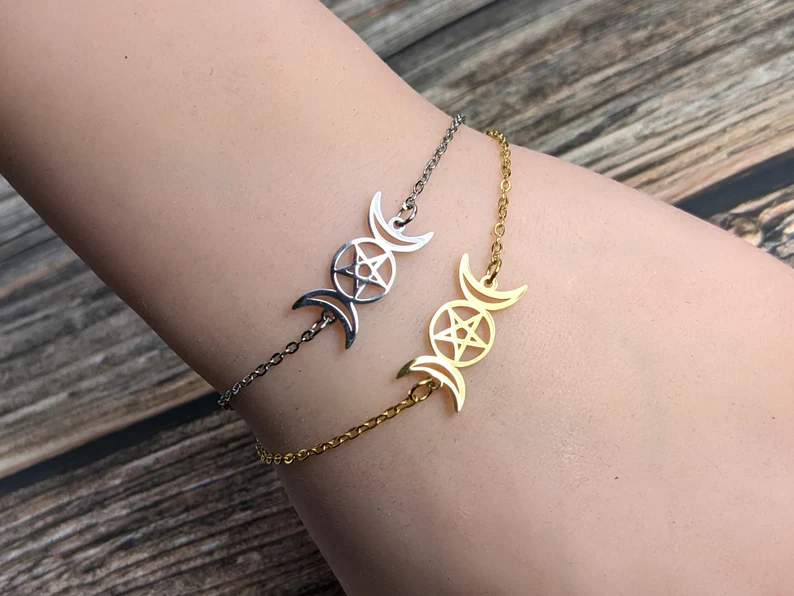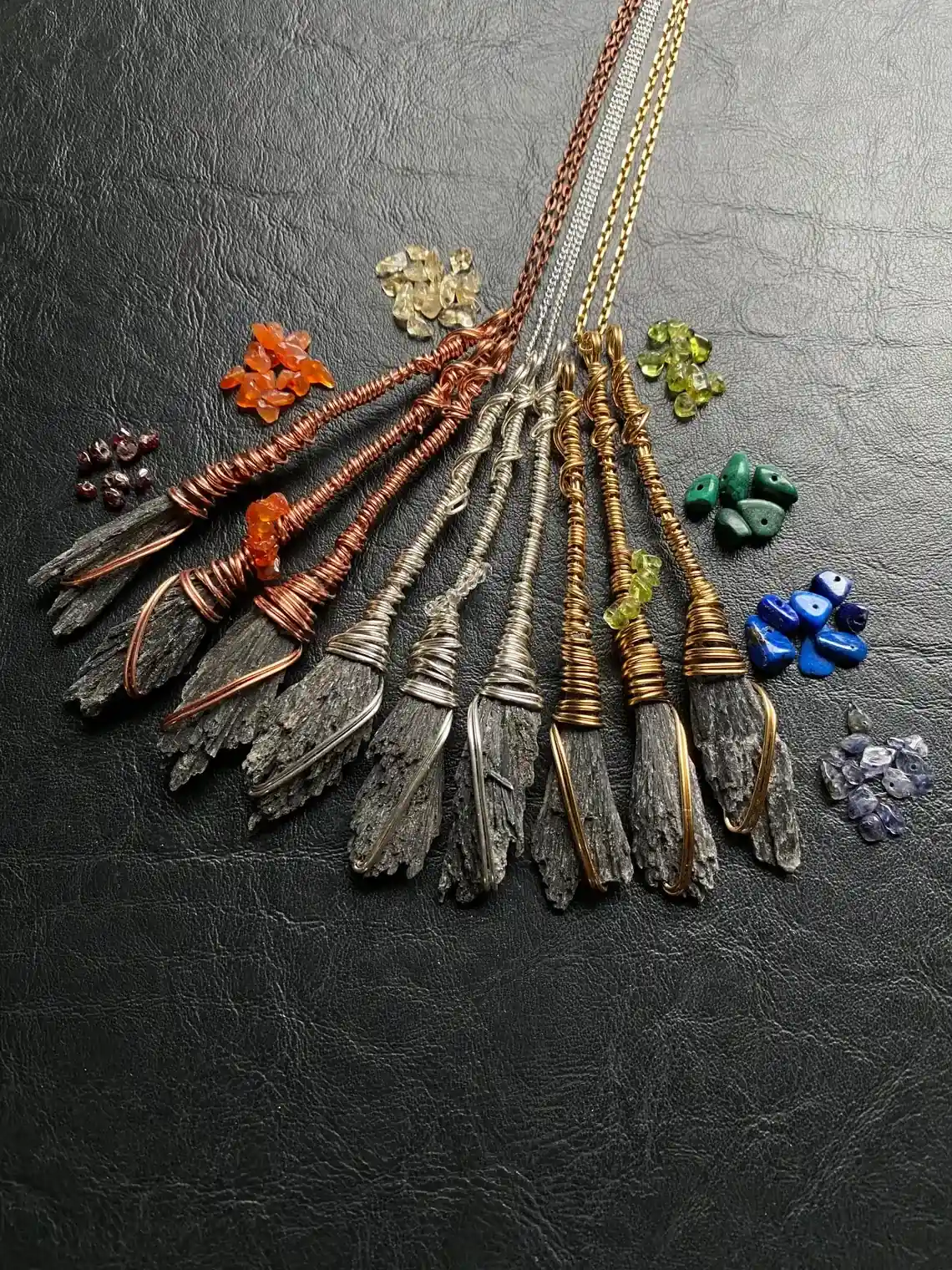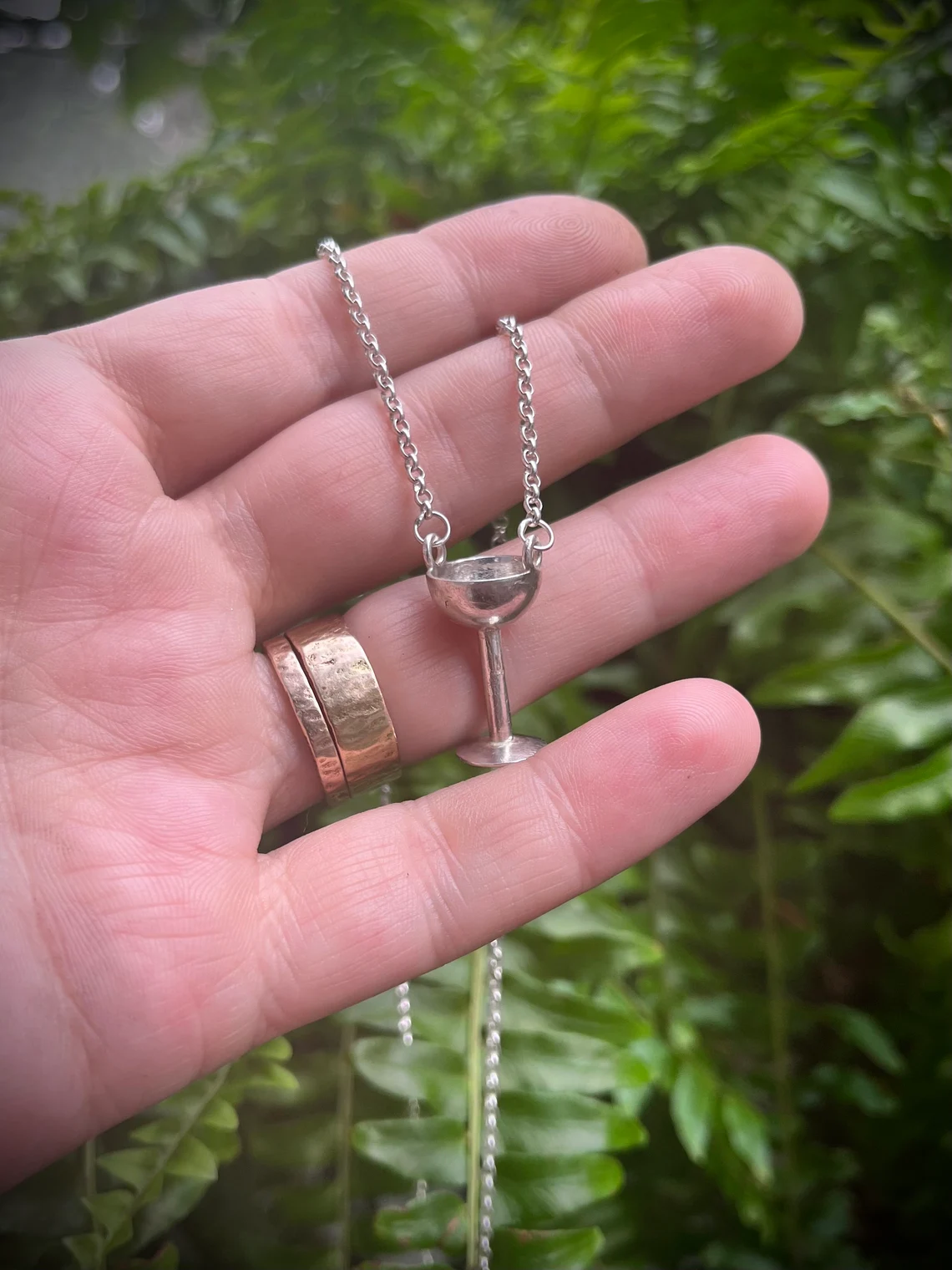
Table of Contents
Wiccan symbols are deeply rooted in nature, history, and the mysteries of the universe. Serving as powerful tools for rituals, meditation, and magic, these symbols connect practitioners to the energies of the cosmos and the rhythms of the Earth. Let’s explore the ancient wisdom and profound meanings that these symbols hold, guiding Wiccans on their spiritual journey.
1. Pentacle/Pentagram

The pentagram is a key symbol in Wicca. It consists of a five-pointed star, and each point represents one of the five elements: Earth, Air, Fire, Water, and Spirit. Enclosed within a circle, the pentagram signifies unity, protection, and the cycle of life.
While often misunderstood or associated with dark practices in popular culture, within Wicca, this symbol primarily stands for balance, harmony, and the interconnectedness of nature and divinity. The pentagram is often used in rituals, ceremonies and as a protective amulet by Wiccans.
2. Triple Moon

The Triple Moon represents the three phases of the Moon: waxing, full, and waning, which resemble the three phases of a woman’s life: maiden, mother, and crone. These phases symbolize the cycle of birth, life, death, and rebirth.
The triple moon highlights the Goddess’s importance in Wicca, emphasizing her various roles and the deep connection between the Moon’s cycles and the natural rhythms of life. Often seen on altars, jewelry, and ritual tools, it serves as a reminder of the ever-changing nature of life and the enduring presence of the Goddess in Wiccan belief.
3. Horned God Symbol

The Horned God is a central figure in Wiccan belief that symbolizes the male aspect of divinity. Often represented with the antlers of a stag, he signifies virility, strength, and the cyclical nature of life and death.
The Horned God is the consort of the Goddess and together, they portray the balance of male and female energies in the universe. While the Goddess is associated with the moon and fertility, the Horned God is linked to the sun and the cycle of seasons. He’s revered as the lord of the animals, the guardian of the forests, and the spirit of the wild hunt.
This symbol highlights the importance of harmony, duality, and respect for nature in Wiccan practices.
4. Spiral Goddess

The Spiral Goddess is recognized by the spiral on her belly, a powerful symbol of life’s cycles, growth, and constant rebirth. This spiral pattern isn’t just in Wicca, but appears in ancient cultures around the world.
The Goddess stands for the power and spirit of women. She connects Earth’s patterns to the sky, showing life’s cycle: being born, living, dying, and starting again. For Wiccans, she reminds us of our strong connection to nature and life’s changes.
5. Witch’s Knot

The Witch’s Knot is a symbol in Wicca made up of circles and lines that look like a maze. Coming from old Celtic stories, it’s believed to protect against bad vibes and harmful spirits. More than just protection, it shows how everything in life is connected.
For Wiccans, it also brings together the four main elements: Earth, air, fire, and water, which are important in their rituals. So, when you see the Witch’s Knot, it’s not just a pretty design. It reminds Wiccans of their deep connection to the universe and how it shields them.
6. Triquetra (Celtic Knot)

The Triquetra Knot is a design with three linked shapes, a symbol with a deep history mainly from Celtic roots. It stands for groups of three ideas, like life stages or nature’s domains.
When Wiccans adopted it, the Triquetra began representing the three faces of the Goddess: the young Maiden, nurturing Mother, and wise Crone. Every part of the knot is connected, showing how everything in life is linked.
This special knot isn’t just decorative; it’s a sign of protection, lasting existence, and balance. Seeing the Triquetra is like a brief journey into old traditions, reminding us of the beauty and balance in the world around us.
7. Ankh

Similar to a cross, but with a loop at the top, the Ankh is an old Egyptian symbol meaning life. When Wicca started using symbols from different regions, the Ankh became a favorite. In Wicca, it shows the connection between a Goddess and a God and the never-ending circle of life and death.
The Ankh is a reminder of a time when gods and magic were everyday things. For Wiccans, it’s more than just an old symbol; it highlights the deep link between life’s mysteries and the powerful forces above and below.
8. Cauldron

Rich in history, the cauldron is a key tool in Wiccan ceremonies and old traditions. Its deep shape, reminding many of a goddess’s womb, stands for birth, change, and renewal. Wiccans use the cauldron for magic, mixing potions and blending intentions with nature’s forces.
It echoes life’s journey, from beginning to end and then starting again. The simmering inside the cauldron shows life’s ongoing changes. Beyond its magical uses, the cauldron reminds us of the endless possibilities when nature and magic come together.
9. Athame (ritual knife)

The Athame is a special double-edged knife important in Wiccan rituals. It’s not for regular cutting, but more as a spiritual tool to focus energy and intentions. Typically, it has a sharp blade with a black handle, underlining its spiritual role.
During ceremonies, Wiccans use it to guide energy, form protective circles, and reach out to higher powers. Some connect the Athame with the fire element, representing change and determination. While it might look like just a fancy knife to some, for Wiccans, it’s a key symbol of their beliefs and their ability to shape their intentions.
10. Besom (Witch’s Broom)

Rich in tradition, the Besom, or Witch’s broom has deep meaning for witches. Made from ash wood and birch twigs, it represents a balance of male and female energies. Witches use the Besom in special ceremonies, like Samhain, to clean their spiritual spaces of bad vibes.
In folklore, the besom is depicted as a witch’s ride, but in reality, you won’t find a witch flying along on a broom. Instead, they use them to connect with nature and the spirit world. This broom stands for cleaning, guarding, and change. It shows how ordinary items can have powerful meanings in the world of Wicca.
11. Green Man

The Green Man is an artistic motif, featuring a face made of leaves. It demonstrates the power and renewal of nature. This old symbol, seen in places like old churches, tells us of nature’s constant presence and impact.
In Wicca, the Green Man is often linked to the Horned God, representing male energy, strength, and wild nature. He reminds us of the cycle of nature: growth, decline, and regrowth. Today, as we face environmental problems, the Green Man stands as a hopeful sign of our deep connection with nature and the need to protect it.
12. Wheel of the Year

The Wheel of the Year is a special Wiccan calendar that has eight main events, or Sabbats. These events follow the sun’s path and the changing seasons. They include important moments like the longest day of the year and times when crops are planted or harvested.
This Wheel helps Wiccans keep track of the seasons, and understand and connect with life’s ups and downs. For example, Yule is a time of new beginnings, while Mabon is a time to be thankful for the harvest. As the Wheel turns, it shows different parts of nature’s cycle, like when flowers bloom in Beltane or when we think deeply during Samhain. For Wiccans, these are more than just dates; it’s a way to remember and celebrate nature’s patterns and our place in them.
13. Witch’s Hat

The iconic witch’s hat, often depicted as a pointed cone with a wide brim, is popularly associated with Halloween costumes today, but its roots run deeper. In Wiccan and pagan traditions, the hat’s conical shape is believed to help direct energy, focusing the wearer’s intent skyward, towards the universe.
Historically, it was a symbol of wisdom, with the pointed tip representing knowledge from higher realms. The wide brim, on the other hand, served to shield and protect the witch from external energies. Far from just a pop culture accessory, the witch’s hat is a potent emblem of power, protection, and a connection to the cosmos.
14. Chalice

A special cup used in Wiccan ceremonies, the Chalice symbolizes womanhood and the Goddess. Often silver, it stands for the Goddess’s mysteries and life’s essential waters. In rituals, the Chalice may hold water, wine, or herbs, and people drink from it to ask for blessings and togetherness.
When used alongside the Athame, which represents masculinity, together they stand for creation and the blend of female and male energies. The Chalice shows life’s many phases, from birth to growth and change. Having it on the ritual table helps Wiccans feel closer to the Goddess and life’s ever-changing flow.
15. Boline (ritual knife)

While the Athame is more for ceremonies, the Boline is used for tasks like cutting herbs or marking candles. Its white handle connects it to the Goddess and the moon’s changing shapes.
In Wicca, tools like the Boline are more than just items; they hold special meanings and energy. This knife, shaped like a crescent moon, reminds Wiccans of the magic in everyday tasks. Its use in rituals isn’t just practical but also symbolizes the caring side of the Goddess and the importance of nature.
Wrapping Up
Wiccan symbols help connect our everyday world to something deeper and spiritual. These symbols tell stories about respect, life’s changes, and how different energies interact. By understanding them, we learn more about life’s ways and Wicca’s old teachings.










